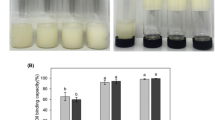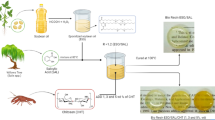Abstract
Effects of different oils on the rheological properties, textural profile, water loss (WL), oil loss (OL) and microstructure of egg-soybean protein isolate (SPI) stabilized emulsion gels were investigated at neutral pH, wherein soybean oil, olive oil and menhaden oil were used to form emulsions. The results showed that viscosity of emulsions progressively increased with the increase of oil content. Similarly, analysis of the rheological behavior of the formulated emulsion gels revealed an increase in the mechanical strength (G’) with the increase in oil concentration, indicating that oil droplets played a significant role in the formation of the gel structure. In addition, at high levels of oil, the hardness and chewiness of emulsion gels were also high, while a slight decrease in springiness and cohesiveness were observed. A linear relationship between hardness and water/oil loss was found, whereas the Pearson correlation suggested that less drainage of water may slow down the outflow of oil. The microstructural images showed a more compact network as a result of the increase of oil content in the formulation. Scarce significant differences were found among emulsion gels formulated with different oil type, suggesting oil composition played a dispensable role on the gelling properties of emulsion gels.







Similar content being viewed by others
References
L. Chen, G.E. Remondetto, M. Subirade, Trends Food Sci. Technol. 17(5), 272–283 (2006)
J. Chen, E. Dickinson, Colloids Surf. B 12(3), 373–381 (1999)
X. Gu, L.J. Campbell, S.R. Euston, Food Res. Int. 42(8), 925–932 (2009)
H. Khalesi, B. Emadzadeh, R. Kadkhodaee, Y. Fang, Int. J. Biol. Macromol. 125, 17–26 (2019)
F. Li, X. Kong, C. Zhang, Y. Hua, Food Hydrocoll. 29(2), 347–355 (2012)
L. Mao, Y.H. Roos, S. Miao, J. Agric, Food Chem. 62(47), 11420–11428 (2014)
C.-H. Tang, F. Liu, Food Hydrocoll. 30(1), 61–72 (2013)
C.-H. Tang, L.-J. Luo, F. Liu, Z. Chen, Food Res. Int. 51(2), 804–812 (2013)
C.-H. Tang, M. Yang, F. Liu, Z. Chen, LWT - food Sci. Technol. 53(1), 15–21 (2013)
M. Yang, F. Liu, C.-H. Tang, Food Res. Int. 52(1), 409–418 (2013)
T. van Vliet, Colloid Polym. Sci. 266(6), 518–524 (1988)
E. Dickinson, Colloids Surf. B 20(3), 197–210 (2001)
T. van Vliet, C.M.M. Lakemond, R.W. Visschers, Curr. Opin. Colloid Interface Sci. 9(5), 298–304 (2004)
E. Dickinson, Food Hydrocoll. 28(1), 224–241 (2012)
T. Farjami, A. Madadlou, Food Hydrocoll. 62, 262–272 (2017)
M. Zhang, J. Li, Y. Su, C. Chang, X. Li, Y. Yang, L. Gu, Food Hydrocoll. 97, 105191 (2019)
M. Zhang, Y. Yang, N.C. Acevedo, Food Chem. 318, 126421 (2020)
H. Liu, X.M. Xu, S.D. Guo, LWT - food Sci. Technol. 40(6), 946–954 (2007)
K. Manoi, S.S.H. Rizvi, Food Hydrocoll. 23(7), 1837–1847 (2009)
D. J. McClements, in Food emulsions –Principles, practice and techniques, ed. by D. J. McClements. (Washington, 1999), pp. 235–266
F. Liu, C.-H. Tang, Food Chem. 127(4), 1641–1647 (2011)
C.K. Reiffers-Magnani, J.L. Cuq, H.J. Watzke, Food Hydrocoll. 13(4), 303–316 (1999)
M. Primacella, T. Wang, N.C. Acevedo, Food Hydrocoll. 96, 529–536 (2019)
X.D. Sun, S.D. Arntfield, Food Hydrocoll. 25(1), 25–31 (2011)
I.-H. Jin, J.-E. Kim, J.-H. Seo, S.-P. Lee, Food Sci. Biotechnol. 22(1), 129–136 (2013)
J. Chen, E. Dickinson, M. Langton, A.-M. Hermansson, LWT - food Sci. Technol. 33(4), 299–307 (2000)
C.-H. Tang, L. Li, J.-L. Wang, X.-Q. Yang, LWT - food Sci. Technol. 40(4), 579–586 (2007)
M. Wu, Y.-L. Xiong, J. Chen, X. Tang, G. Zhou, J. Food Sci. 74(4), E207–E217 (2009)
C.-H. Tang, L. Chen, E.A. Foegeding, J. Agric. Food Chem. 59(8), 4071–4077 (2011)
V.L. Sok Line, G.E. Remondetto, M. Subirade, Food Hydrocoll. 19(2), 269–278 (2005)
X. Wang, Z. He, M. Zeng, F. Qin, B. Adhikari, J. Chen, Food Chem. 221, 130–138 (2017)
M. Færgemand, B.S. Murray, E. Dickinson, J. Agric. Food Chem. 45(7), 2514–2519 (1997)
Acknowledgements
The authors would like to thank for the financial support of the National Key Research and Development Program of China [No. 2018YFD0400303] and the project of China Scholarship Council. This paper is a product of the Iowa Agriculture and Home Economics Experiment Station, Ames, Iowa. Project No. IOW03902 sponsored by Hatch Act and State of Iowa funds.
Funding
The work was supported by the National Key Research and Development Program of China [No. 2018YFD0400303] and the project of China Scholarship Council. Also this paper is a product of the Iowa Agriculture and Home Economics Experiment Station, Ames, Iowa. Project No. IOW03902 sponsored by Hatch Act and State of Iowa funds.
Author information
Authors and Affiliations
Corresponding authors
Ethics declarations
Conflict of Interest
The authors declare no conflict of interest.
Additional information
Publisher’s Note
Springer Nature remains neutral with regard to jurisdictional claims in published maps and institutional affiliations.
Rights and permissions
About this article
Cite this article
Zhang, M., Yang, Y. & Acevedo, N.C. Effect of Oil Content and Composition on the Gelling Properties of Egg-SPI Proteins Stabilized Emulsion Gels. Food Biophysics 15, 473–481 (2020). https://doi.org/10.1007/s11483-020-09646-8
Received:
Accepted:
Published:
Issue Date:
DOI: https://doi.org/10.1007/s11483-020-09646-8




